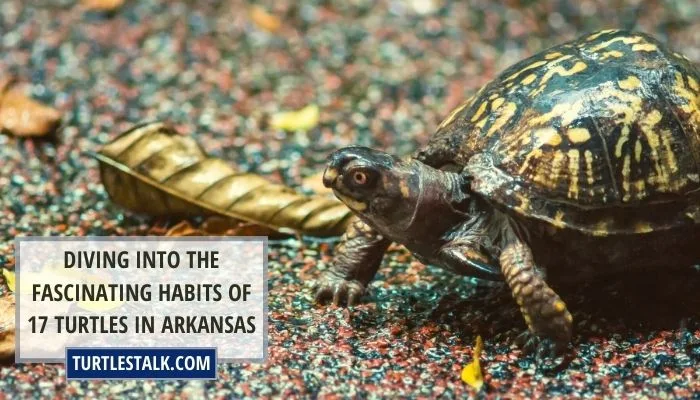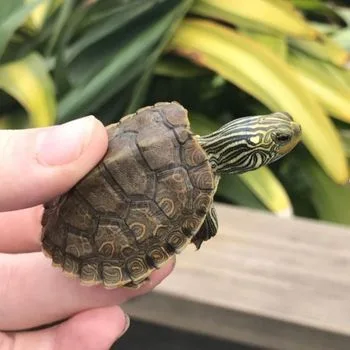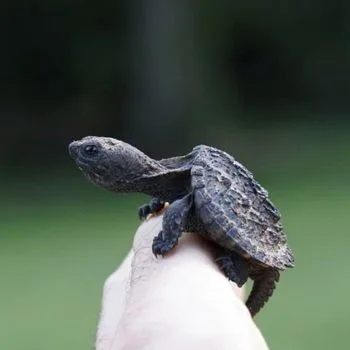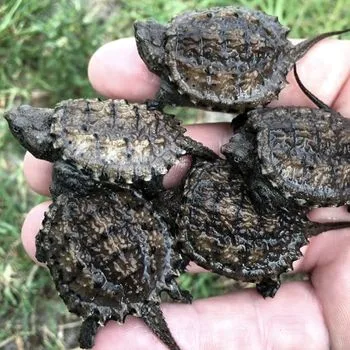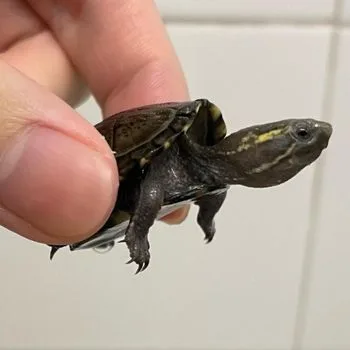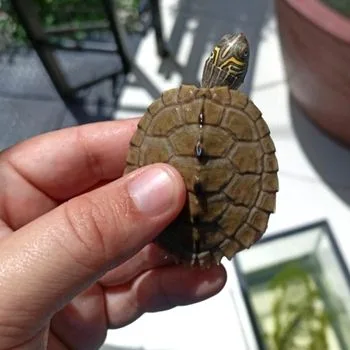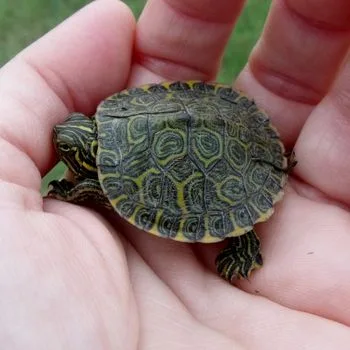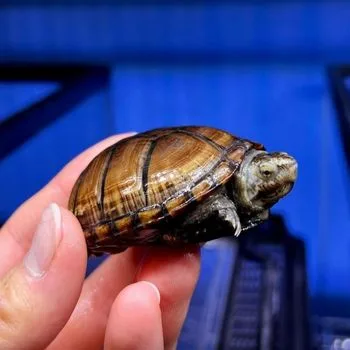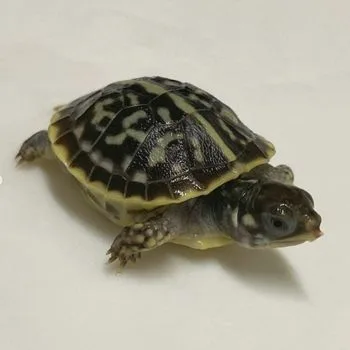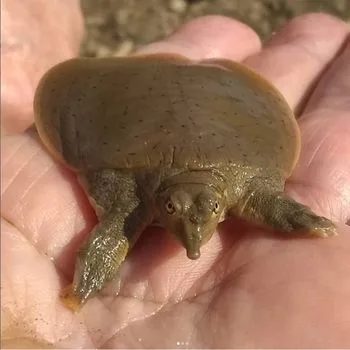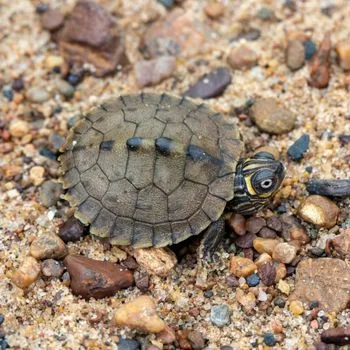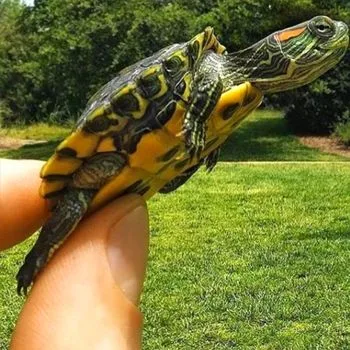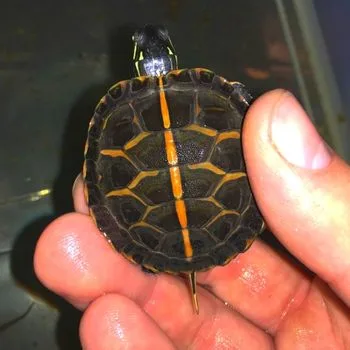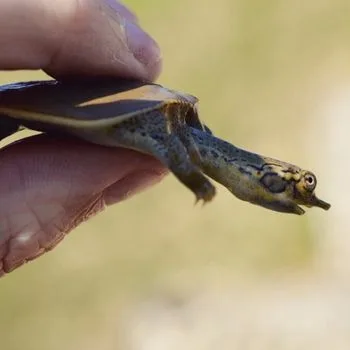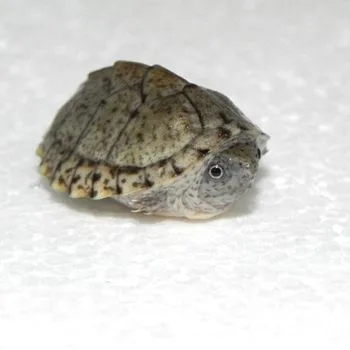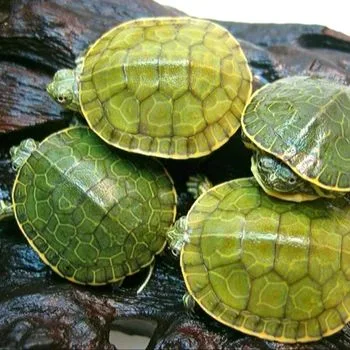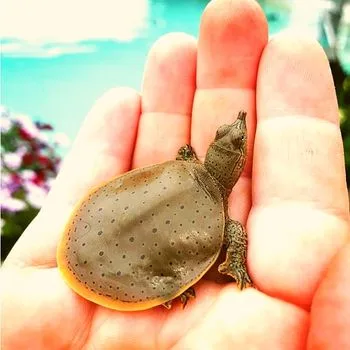Diving Into the Fascinating Habits of 17 Turtles in Arkansas
The state of Arkansas is home to a wide variety of turtles from 11 different genera, spread across four families. From the Common Map Turtle to the Alligator Snapping Turtle, these species can be found in many habitats throughout the state.
These fascinating creatures have been around since prehistoric times and are an important part of our ecology and environment. They play an essential role as predators that help keep animal populations balanced, while also serving as prey for other animals like snakes and birds.
Here we will explore 17 of these turtles and their importance to Arkansas’ ecosystems.
| # | Name | Details | Image |
| 1 | Common Map Turtle (Graptemys Geographica) |
| 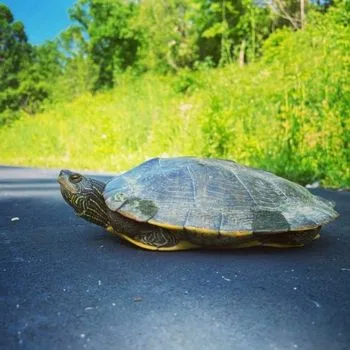 |
| 2 | Common Snapping Turtle (Chelydra serpentina) |
| 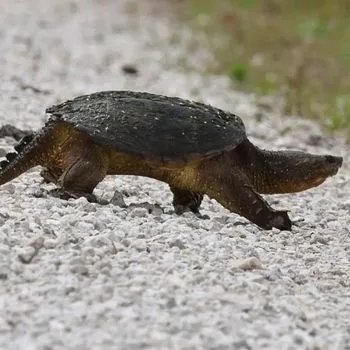 |
| 3 | Alligator Snapping Turtle (Macrochelys Temminckii) |
| 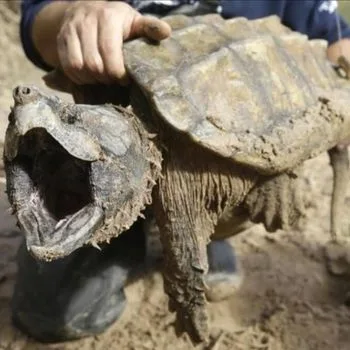 |
| 4 | Common Musk Turtle (Sternotherus Odoratus) |
| 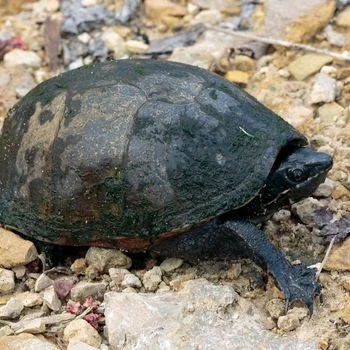 |
| 5 | Mississippi Map Turtle (Graptemys Pseudogeographica Kohnii) |
| 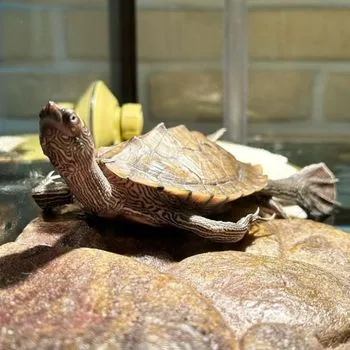 |
| 6 | Missouri River Cooter (Pseudemys Concinna) |
| 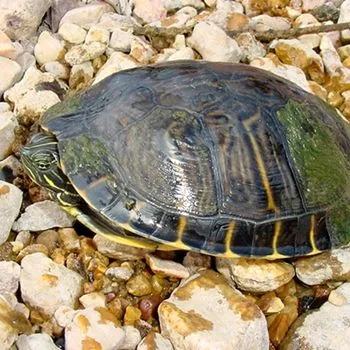 |
| 7 | Eastern Mud Turtle (Kinosternon Subrubrum) |
| 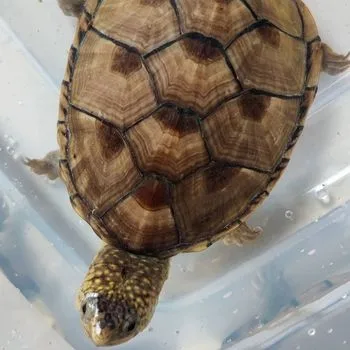 |
| 8 | Ornate Box Turtle (Terrapene Ornata Ornata) |
| 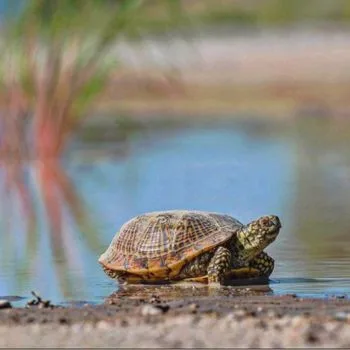 |
| 9 | Midland Smooth Softshell Turtle (Apalone mutica mutica) |
| 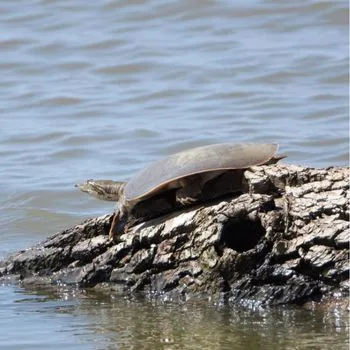 |
| 10 | Ouachita Map Turtle (Graptemys Ouachitensis) |
| 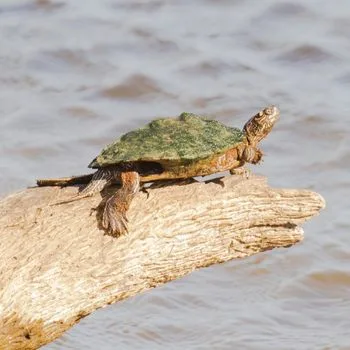 |
| 11 | Red Eared Slider (Trachemys Scripta Elegans) |
| 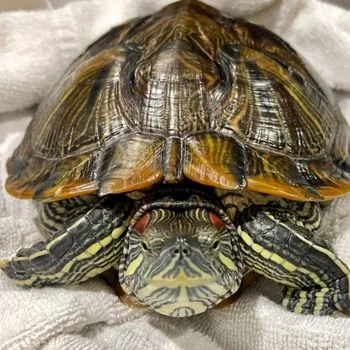 |
| 12 | Southern Painted Turtle (Chrysemys picta) |
| 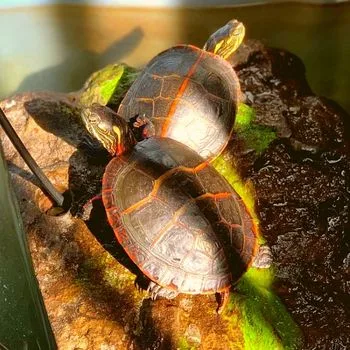 |
| 13 | Three-toed Box Turtle (Terrapene Carolina Triunguis) |
| 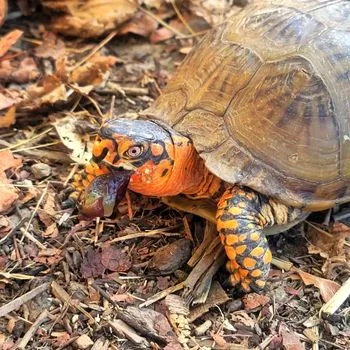 |
| 14 | Pallid Spiny Softshell (Apalone Spinifera Pallida) |
| 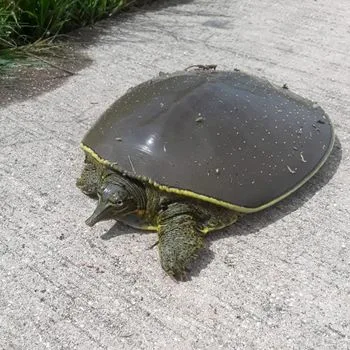 |
| 15 | Razor-backed Musk Turtle (Sternotherus Carinatus) |
| 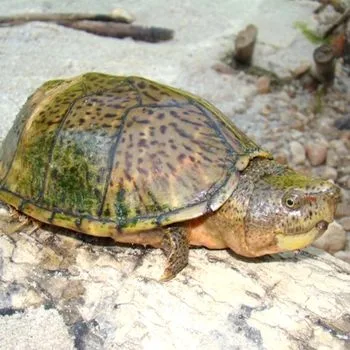 |
| 16 | Western Chicken Turtle (Deirochelys Reticularia Miaria) |
| 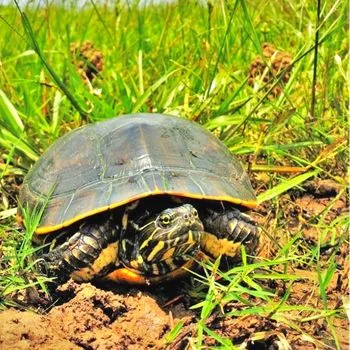 |
| 17 | Western Spiny Softshell (Apalone Spinifera) |
| 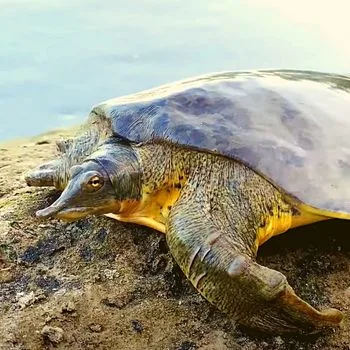 |
| 18 | Mojave Desert Tortoise (Gopherus Agassizii) |
| 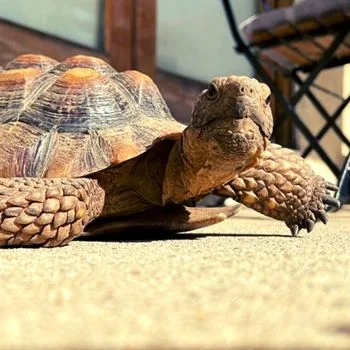 |
How Can I Create a Suitable Habitat for My Turtle with Sand in Their Tank?
When it comes to the turtle tank sand debate, creating a suitable habitat for your turtle is crucial. Use fine-grain sand as a substrate, as it mimics their natural environment and allows for digging and burrowing. Make sure to clean the sand regularly to maintain a healthy living environment for your turtle.
17 Turtles You Can Find in Arkansas
In total, there are 17 species of turtles in the state of Arkansas. This guide will take you on an exploration through each turtle type and provide tips for providing them with proper care. So, let’s get started on our journey into discovering all the wonders that these reptiles have to offer!
1. Common Map Turtle (Graptemys Geographica)
- Family: Emydidae
- Genus: Graptemys
- Type: Aquatic turtle
- Natural Habitat: Freshwater rivers, streams, and ponds in the eastern united states
- Lifespan: 20 years
- Also Known As: Map turtle, northern map turtle
- Maximum Size: 8-10 inches
- Maximum Weight: 1-2 pounds
- Prone to Diseases: Respiratory infections and shell rot
- Aggression Level: Not aggressive
- Predators: Otters, raccoons, birds of prey, and large fish
- Domestication: Can be kept as pets
Deep in the freshwater rivers, streams and ponds of the eastern United States lies a remarkable species of turtle – the Common Map Turtle (Graptemys geographica). This species is part of the Emydidae family, and is well-adapted to aquatic life, boasting powerful webbed feet, a long neck and flat shell for swimming. Adults can grow up to 8-10 inches in length with little size variation between males and females, ranging from 1 to 2 pounds in weight.
The Common Map Turtle is often confused with other members of its genus; however, it can be easily identified by its unique pattern of yellow lines that resemble a map on its shell. Its lifespan can reach up to 20 years when kept in proper conditions. It’s important to note that this species is illegal to own as a pet in some states due to varying regulations; therefore it’s essential to check your local state laws before attempting ownership.
These turtles may not be aggressive by nature but they may bite if threatened or disturbed. They are also prone to diseases such as respiratory infections and shell rot if kept in unsanitary conditions – so it’s important to take special care when handling them if you decide to keep them as pets.
As far as predators go, otters, raccoons, birds of prey and large fish all pose a threat despite their adaptations for aquatic life. Thankfully, there are no signs that this magnificent species is currently endangered here in Arkansas.
2. Common Snapping Turtle (Chelydra serpentina)
- Family: Chelydridae
- Genus: Chelydra
- Type: Freshwater turtle
- Natural Habitat: Freshwater habitats such as lakes, rivers, and swamps
- Lifespan: 50 years
- Maximum Size: 19 inches
- Maximum Weight: 40 pounds
- Prone to Diseases: Fungal infections and shell rot
- Aggression Level: Not aggressive until provoked
- Predators: River otters, bears and coyotes
- Domestication: Not recommended as pets
The Common Snapping Turtle, scientifically known as Chelydra serpentina, is an aquatic species native to freshwater habitats such as lakes, rivers and swamps. These turtles are highly adaptable and can live up to 50 years in the wild.
Adult Common Snapping Turtles typically measure 10-16 inches in shell length but can grow up to 19 inches and weigh around 40 pounds. They have a powerful bite with an estimated pressure of over 600 psi, making them one of the strongest biters among reptiles. Despite their strength they are generally not aggressive animals, though it is best to not provoke them and take caution around them.
Common Snapping Turtles often face threats from predators such as river otters, bears and coyotes when living out in the wild.
Unfortunately, their habitat is also threatened by human activities such as development and pollution which can lead to a decrease in population numbers if conservation efforts are not taken soon here in Arkansas.
Although they make fascinating pets due to their long lifespan of up to 50 years when cared for properly, some states have regulations or restrictions on owning them so check with local authorities before acquiring this species as a pet.
These turtles have webbed feet for swimming and a long tail for propulsion allowing them to move quickly through water which also makes them difficult prey for predators.
Furthermore, although they occupy multiple states across North America from Alabama to Wyoming there is no other name than the Common Snapping Turtle so it’s easy to identify.
It should be noted that this species does not carry any significant disease that can be transmitted to humans yet they may still be prone to diseases like fungal infections or shell rot when kept in unsanitary conditions so proper care must be taken here in Arkansas when considering owning one of these remarkable creatures as a pet.
3. Alligator Snapping Turtle (Macrochelys Temminckii)
- Family: Chelydridae
- Genus: Macrochelys
- Type: Freshwater turtle
- Natural Habitat: Slow-moving rivers, canals, lakes, and swamps in the southeastern united states
- Lifespan: 60-70 years
- Maximum Size: 30 inches
- Maximum Weight: 220 pounds
- Aggression Level: Moderate
- Predators: Large fish, birds of prey, and humans
- Domestication: Not recommended as pet
The Alligator Snapping Turtle (Macrochelys temminckii) is a large freshwater turtle native to the southeastern United States. Adults can reach up to 30 inches in length and weigh up to 220 pounds. Juvenile alligator snapping turtles are much smaller, usually between 4-10 inches in length. When you’ll come across this species in Arkansas, you’ll notice that it has a very unique appearance, with an oversized head and a spiked tail that looks like an alligator’s claw.
The shell of this turtle is dark brown or black with yellow spots and stripes over it, giving the impression of scales on an alligator’s back.
Alligator snapping turtles are powerful predators and their bite force is strong enough to break through bone. They feed mainly on fish but also consume invertebrates, amphibians, and other turtles. These turtles are ambush predators, waiting for prey to come close before attacking. They are not considered aggressive towards humans but should still be handled with caution as they may bite if startled.
In the wild, alligator snapping turtles can live up to 60-70 years and have few natural predators due to their large size. However, their populations have declined in some areas due to habitat loss, illegal harvesting, and pollution. In order to protect this species from further decline, many states regulate or ban the possession of alligator snapping turtles as pets. Furthermore, it is important that you research the specific laws and regulations of your state or municipality before owning a pet turtle.
4. Common Musk Turtle (Sternotherus Odoratus)
- Family: Kinosternidae
- Genus: Sternotherus
- Type: Terrestrial and aquatic turtle
- Natural Habitat: Streams, rivers, ponds, and swamps in eastern north america
- Lifespan: 10-20 years
- Also Known As: Stinkpot
- Maximum Size: 4-8 inches
- Maximum Weight: 0.7 pounds
- Prone to Diseases: Respiratory infections and shell rot
- Aggression Level: Agressive but not known to bite humans
- Predators: Raccoons, mink, birds of prey, and large fish
- Domestication: Can be kept as pets
The Common Musk Turtle (Sternotherus Odoratus) is a terrestrial and aquatic turtle found in streams, rivers, ponds, and swamps throughout the eastern United States. This species can reach an impressive length of 4-8 inches when fully grown, with an average weight of 0.7 pounds. Interestingly, these turtles are also known as ‘Stinkpots’ due to their ability to secrete a musky odour when alarmed or threatened.
Their flat carapace makes them well adapted for life in the water, with strong webbed feet and sharp claws helping them cling onto rocks or vegetation while searching for food. As omnivores they feed on snails, clams and other insects as well as plant matter such as algae and leaves – making them a vital part of the local ecosystem here in Arkansas. They are generally non-aggressive but may bite if disturbed or threatened by predators such as river otters, raccoons, mink and birds of prey.
The Common Musk Turtle is not currently listed as an endangered species but habitat loss due to human activities such as development and pollution can lead to a decrease in population numbers – especially without proper conservation efforts. Additionally, illegal pet trade can be an issue that affects their vulnerability so it’s important to check local regulations before acquiring this species as a pet.
Despite all this however, with proper care these turtles have been known to live up to 20 years making them great companions for experienced keepers who are willing to put in the effort necessary for their special care needs here in Arkansas.
5. Mississippi Map Turtle (Graptemys Pseudogeographica Kohnii)
- Family: Emydidae
- Genus: Graptemys
- Type: Freshwater turtle
- Natural Habitat: Mississippi river basin in the united states, in large rivers, lakes, and swamps, with mud or sandy bottoms and abundant aquatic vegetation
- Lifespan: 30 years
- Maximum Size: Males: 7 inches, females: 12 inches
- Maximum Weight: Males: 1 pounds, females: 2 pounds
- Prone to Diseases: Respiratory infections, shell rot, and metabolic bone disease
- Aggression Level: Mildly aggressive
- Predators: Large fish and raccoons
- Domestication: Can be kept as pet
The Mississippi Map Turtle (Graptemys pseudogeographica kohnii) is a unique freshwater turtle native to the Mississippi River Basin. They can be found in large rivers, lakes, and swamps with mud or sandy bottoms and plenty of aquatic vegetation.
Males typically reach 5-7 inches in length, while females can grow up to 8-12 inches. The males generally weigh 200-400 grams, and females can weigh up to 1 kilogram. Although they are not aggressive towards humans and rarely bite, it is important to observe them from a respectful distance if spotted in their natural environment – particularly around Arkansas where they inhabit.
Mississippi Map Turtles are sometimes kept as pets but require proper care and housing if taken into captivity. Inadequate nutrition, poor ventilation or unclean environments may cause respiratory infections or shell rot.
Since they spend much of their time in the water, they have webbed feet in order to swim quickly and dive deep when necessary. Unfortunately, populations in some areas are declining due to habitat destruction and over-collection for the pet trade despite them not being listed as an endangered species.
In addition to the Mississippi River Basin itself, these fascinating creatures have also been observed throughout Illinois, Iowa, Missouri, Tennessee, Arkansas, Kentucky – and possibly Alabama, Indiana and Ohio as well! If you find yourself exploring Arkansas, keep your eyes open for this stunning species – you might just get lucky!
6. Missouri River Cooter (Pseudemys Concinna)
- Family: Emydidae
- Genus: Pseudemys
- Type: Freshwater turtle
- Natural Habitat: Inland rivers and streams, swamps and marshes
- Lifespan: 30 years
- Maximum Size: 17 inches
- Maximum Weight: 11 pounds
- Prone to Diseases: Respiratory infections, shell rot, and other health problems
- Aggression Level: Not aggressive
- Predators: Birds, mammals, and reptiles
- Domestication: Can be kept as pets
The Missouri River Cooter, also known by its scientific name Pseudemys concinna, is a freshwater turtle native to the United States. These aquatic creatures are found in rivers and streams, swamps and marshes, particularly around Arkansas. With an average lifespan of around 30 years, these turtles can grow up to 17 inches in length and weigh 11 pounds on average. Although they are not aggressive towards humans or other animals, juvenile turtles may be preyed upon by birds, mammals and reptiles.
In captivity, they require proper nutrition and housing in order to avoid shell rot or respiratory infections. Many US states do not have restrictions on keeping them as pets; however their overcollection for the pet trade has led to population decline in certain areas. They are strong swimmers and well-adapted to life in salt or brackish water habitats. Additionally, their webbed feet help them navigate through waters with swift currents.
Furthermore, the Missouri River Cooter enjoys a balanced diet comprised of plant material such as lettuce and commercial turtle feed available at pet stores. As omnivores, they may also consume animal proteins including insects or crayfish – furthering their adaptation to their natural environments. So if you encounter one of these majestic creatures near Arkansas, take the time to observe from a respectful distance!
7. Eastern Mud Turtle (Kinosternon Subrubrum)
- Family: Kinosternidae
- Genus: Kinosternon
- Type: Mud turtle
- Natural Habitat: Freshwater wetlands, swamps, and slow-moving streams
- Lifespan: 30 years
- Maximum Size: 5 inches
- Maximum Weight: 9.27 ounces
- Aggression Level: Low
- Predators: Raccoons, snakes, and birds of prey
- Domestication: Not suitable as a pet
The Eastern Mud Turtle (Kinosternon subrubrum) is a small freshwater turtle found in the southeastern United States, including Arkansas. This species of turtle is known for its highly aquatic adaptations and webbed feet, which make it well-suited to life in slow-moving streams, swamps, and wetlands. The Eastern Mud Turtle can reach up to 5 inches in length and has a maximum weight of 9.27 ounces. It is not aggressive, but may bite if provoked—so exercise caution when near any wild turtles!
The diet of the Eastern Mud Turtle consists primarily of aquatic invertebrates such as snails, worms, and insects. They are also opportunistic scavengers, meaning they will take advantage of carrion when available. Predators of this species include raccoons, snakes, and birds of prey. The lifespan of these turtles is up to 30 years in the wild and due to their abundance across the southeastern United States are not listed as threatened or endangered.
Although they do not make suitable pets due to their size and temperament being unsuitable for captivity, taking care to observe local wildlife regulations is important when interacting with wild Eastern Mud Turtles in Arkansas . Taking steps such as preserving their natural habitats helps protect this species from destruction or poaching—ensuring they remain an iconic part of our environment for many more years to come!
8. Ornate Box Turtle (Terrapene Ornata Ornata)
- Family: Emydidae
- Genus: Terrapene
- Type: Terrestrial turtle
- Natural Habitat: Open landscapes such as pastures, prairies, and lightly forested areas
- Lifespan: 30 – 40 years
- Also Known As: Western box turtle
- Maximum Size: 4-5 inches
- Maximum Weight: 1-1.5 pounds
- Prone to Diseases: Vitamin deficiency, respiratory diseases
- Disease Carrier: Salmonella
- Aggression Level: Males display a tendency towards aggressive behavior, including biting and clashing their shells against each other
- Predators: Birds, such as crows, raptors, and ravens; domestic cats and dogs; opossums; raccoons; skunks; snakes; and even adult box turtles
- Domestication: Can be kept as pet
Have you ever wondered what kind of magical creature might be lurking in the forests and wetlands of Arkansas? Well, say hello to the Ornate Box Turtle! This amazing animal is closely related to its box turtle cousins, but it can also be identified by its intricate patterned shell – hence its name.
With a small head and body covered in an ornately patterned carapace or upper shell that’s usually brown with yellowish-orange markings, these turtles stand out from the crowd. Their distinctive appearance isn’t the only thing that sets them apart, though. These turtles also have unique habits that make them fascinating to observe. For example, they are known to be fairly solitary creatures, often spending their time alone in the water or basking on rocks or logs. Their diet consists mainly of aquatic plants, small fish, and insects, and they are known to migrate long distances in search of food and suitable nesting sites. Overall, the habits of turtles make them an intriguing species to study and learn about.
It spends most of its time hiding under cover while searching for food such as snails and insects, often seen out on warm summer days. So next time you take a walk through Arkansas, keep your eyes open for the Ornate Box Turtle – after all, who knows what else might be living there!
9. Midland Smooth Softshell Turtle (Apalone mutica mutica)
- Family: Trionychidae
- Genus: Apalone
- Type: Freshwater turtle
- Natural Habitat: Slow-moving streams, rivers, lakes, and ponds in the midwestern and southeastern united states
- Lifespan: 25-30 years
- Maximum Size: 10 inches
- Prone to Diseases: Shell rot and respiratory infections
- Aggression Level: Mild, non-aggressive species
- Predators: Alligators, large fish, and snapping turtles
- Domestication: Can be kept in captivity
Native to the midwestern and southeastern United States, including Arkansas, the Midland Smooth Softshell Turtle (Apalone mutica mutica) is a majestic freshwater species.
With adults typically reaching 7-8 inches in length and some individuals even reaching up to 10 inches, these turtles weigh an average of 1-4 pounds with no significant size variations between males and females. They can be found in slow-moving streams, rivers, lakes, and ponds and display mild, non-aggressive behavior.
Despite not being commonly kept as pets, if taken into captivity they require proper care such as providing a balanced diet and a clean environment. Furthermore, they may be vulnerable to shell rot and respiratory infections if kept in unclean or poorly ventilated environments. Predation from alligators, large fish, birds of prey or raccoons may occur whilst eggs and hatchlings are prone to predation from skunks or other predators.
Although not currently listed as endangered by IUCN standards – populations of Midland Smooth Softshell Turtles may be declining due to habitat loss and collection for the pet trade.
These aquatic creatures are also found in Arkansas, Illinois, Indiana, Iowa, Kansas, Kentucky, Louisiana, Missouri , Mississippi , Ohio , Oklahoma , Tennessee ,and Texas. Respectful caution should also be taken when spotting a Midland Smooth Softshell Turtle since although rarely aggressive towards humans – they are still considered vulnerable according to IUCN standards and hence should not be disturbed needlessly even if encountered in nature during your visit at Arkansas.
10. Ouachita Map Turtle (Graptemys Ouachitensis)
- Family: Emydidae
- Genus: Graptemys
- Type: Aquatic turtle
- Natural Habitat: Slow-moving freshwater rivers, streams, and lakes
- Lifespan: 30 – 50 years
- Also Known As: Sawback
- Maximum Size: Males: 3 to 6.5 inches, females: 4.0 to roughly 11 inches
- Maximum Weight: 1.5 – 4.5 pounds
- Prone to Diseases: Shell rot, respiratory infections
- Disease Carrier: Salmonella
- Aggression Level: Not aggressive
- Predators: Raccoons, skunks, and foxes
- Domestication: Can be kept as pet
Have you ever seen the magnificent Ouachita Map Turtle (Graptemys ouachitensis)? This freshwater turtle is found in slow-moving rivers, streams, and oxbow lakes in Arkansas and Oklahoma.
With adult sizes measuring 8-11 inches in length, these turtles make for a great pet – though it’s important to check local regulations as Arkansas may have different restrictions when it comes to owning a turtle.
They are not aggressive by nature but can fall prey to predators like raccoons and otters or even large fish or birds of prey on occasion. When cared for properly, these turtles can live up to 20-30 years!
11. Red Eared Slider (Trachemys Scripta Elegans)
- Family: Emydidae
- Genus: Trachemys
- Type: Aquatic turtle
- Natural Habitat: Streams, rivers, ponds, lakes, swamps, and marshes
- Lifespan: 20 – 30 years
- Also Known As: Red-eared terrapin
- Maximum Size: 7 – 12 inches, females get larger than 12 inches
- Maximum Weight: 3 – 6 pounds
- Prone to Diseases: Respiratory infections, shell rot, and other diseases if kept in unsanitary conditions.
- Disease Carrier: Salmonella
- Aggression Level: Not aggressive
- Predators: Raccoons, otters, fish, frogs, snakes, skunks and birds
- Domestication: Can be kept as pets
The Red Eared Slider (Trachemys scripta elegans) is a freshwater reptile with a striking appearance. Found in Arkansas’s waterways, these turtles can reach up to 10-12 inches long as adults and can live for an impressive 30 years. They have webbed feet that are adapted for swimming, making them incredibly agile aquatic creatures.
Males and females exhibit different size ranges, with males being more diminutive compared to the females and juveniles measuring only 2-3 inches when fully grown. Although they may take on aggressive postures if threatened, their bite force is not enough to cause any damage to humans or other larger animals.
It’s important that we respect the habitats of these amazing reptiles so that future generations will be able to enjoy them too – keep their environments clean by disposing of garbage properly and avoid disturbing the fragile ecosystems where they make their homes!
12. Southern Painted Turtle (Chrysemys picta)
- Family: Emydidae
- Genus: Chrysemys
- Type: Aquatic turtle
- Natural Habitat: Likes bodies of water with soft mud floors and abundant aquatic plants, e.g. rivers, lakes, wetlands, oxbows, ponds, ditches, and reservoirs.
- Lifespan: Usually 20 – 30 years, but in better habitat can live up to 50 years
- Maximum Size: 4 – 6 inches
- Maximum Weight: Gets about 1 pound
- Prone to Diseases: Vitamin deficiencies, metabolic bone disease, and intestinal parasites
- Disease Carrier: Salmonella
- Aggression Level: Aggressive baskers
- Predators: Raccoons, skunks, foxes, herons, other birds, snakes, and large predaceous fish
- Domestication: Can be kept as pets
The Southern Painted Turtle (Chrysemys Picta) is one of the most recognizably patterned freshwater turtles native to Arkansas. These aquatic reptiles can be found in wetland habitats such as ponds, streams and slow-moving rivers. Adults typically reach a length between 4.5 to 10 inches – with females being larger than their male counterparts while they also maintain an impressive lifespan of up to 30 years!
These turtles have webbed feet, streamlined shells and retractable heads that provide them with excellent adaptations for swimming along with protection from predators. Among such predators are crows, raccoons, skunks, herons – and even larger fish that pose a threat if populations become too large. The aquatic skills of turtles are also well-developed, allowing them to navigate swiftly and gracefully through the water in search of food and suitable habitats. Their ability to hold their breath for long periods of time and their streamlined bodies make them efficient and agile swimmers. In addition, their webbed feet provide them with excellent propulsion in the water, enabling them to quickly escape potential threats.
Although these animals are not considered endangered species overall, some populations may be declining due to habitat loss or exploitation so it’s important for us all to do our part in preserving them where possible. As for those considering keeping them as pets? Please check local regulations first before taking any turtle home!
13. Three-toed Box Turtle (Terrapene Carolina Triunguis)
- Family: Emydidae
- Genus: Terrapene
- Type: Semi-aquatic turtle
- Natural Habitat: Humid areas such as marshes and grassy lands
- Lifespan: 30 – 40 years
- Maximum Size: 5 – 7 inches
- Maximum Weight: Up to 2 pounds
- Prone to Diseases: Clinical mycoplasma infections, mbd
- Disease Carrier: Salmonella
- Aggression Level: Not aggressive
- Predators: Mammals, such as raccoons, muskrats, birds and large fishes.
- Domestication: Illegal to possess without permit in most states
This remarkable reptile inhabits deciduous forests, grasslands, and wetlands across parts of the eastern and central United States including Arkansas.
Its average length is 4.5 to 5.5 inches while its weight averages between 0.5 to 1 pound with no size or gender differences seen in adults. Although they are mild by nature, these reptiles need proper care and maintenance if kept as pets – some states like Florida have even put restrictions on owning them as a pet!
Fortunately, their strong shells protect them from predators like snakes, raccoons, and skunks; however human activities such as habitat destruction have resulted in this species being listed as a special concern in some states due to the loss of habitats.
14. Pallid Spiny Softshell (Apalone Spinifera Pallida)
- Family: Trionychidae
- Genus: Apalone
- Type: Aquatic turtle
- Natural Habitat: Highly-oxygenated rivers, creeks, canals, impoundments, lakes, and oxbows (concentrated with a soft sand or muddy bottoms)
- Lifespan: Up to 50 years
- Maximum Size: Males: roughly 10 inches, females: 15 – 18 inches
- Maximum Weight: Roughly 2.7 pounds
- Prone to Diseases: Shell rot and other fungal infections
- Aggression Level: Aggressive when in danger, inflicts painful bites
- Predators: Raccoons, herons, and large fishes
- Domestication: Can be kept as pet
Have you ever heard of the Pallid Spiny Softshell Turtle? This stunningly patterned semi-aquatic reptile can be found in slow-moving waters like ponds, lakes, rivers and marshes in Arkansas and across North America.
With an average lifespan of 15 to 20 years, these turtles usually grow up to 17–18 inches long and weigh 5–15 pounds for females while males are lighter at 2–7 pounds. Though they generally don’t bite humans, juvenile painted turtles are still vulnerable to predation from raccoons, large fish and birds of prey.
Keeping them as pets is legal but check your local laws before bringing one home! Do watch out for diseases such as shell rot or respiratory infections so ensure clean living conditions when caring for them!
15. Razor-backed Musk Turtle (Sternotherus Carinatus)
- Family: Kinosternidae
- Genus: Sternotherus
- Type: Aquatic turtle
- Natural Habitat: Heavily vegetated shallow ponds, slow moving water swamps, and streams
- Lifespan: 20 – 40 years
- Also Known As: Carinated musk turtle
- Maximum Size: Roughly 6 inches
- Maximum Weight: 0.5 to 1 pound
- Prone to Diseases: Vitamin diseases, abscesses, shell infections and fractures, and parasites
- Aggression Level: Aggressive
- Predators: Raccoons, skunk, fox, birds of prey, bullfrogs. largemouth bass, alligators
- Domestication: Popularly kept as pets
The Razor-backed Musk Turtle (Sternotherus carinatus) is a unique species of reptile found across Arkansas. This small but powerful creature can reach up to 5-7 inches in length, with males being smaller than females.
It has webbed feet and the ability to hold its breath for long periods, making it well suited to life in freshwater rivers, swamps and streams.
Though mildly aggressive, it rarely bites humans if feeling threatened. Unfortunately wild populations have been impacted by habitat loss and hunting so we must respect their natural habitats if we want them to survive for generations more to come! Let’s make sure this remarkable animal continues thriving in Arkansas.
16. Western Chicken Turtle (Deirochelys Reticularia Miaria)
- Family: Emydidae
- Genus: Deirochelys
- Type: Semi-aquatic turtle
- Natural Habitat: Lakes, swamps, ponds and streams characterized by slow pace and shallow depth.
- Lifespan: 15 – 25 years
- Maximum Size: Up to 10 inches
- Maximum Weight: 0.5 – 4 pounds
- Prone to Diseases: Respiratory diseases, metabolic bone issues
- Disease Carrier: Salmonella
- Aggression Level: Hostile behavior between males can be particularly noticeable.
- Predators: Raccoons, otters, ospreys, weasels, large fish and coyotes
- Domestication: Can be kept as pet if collected from a legal collector
Welcome to the remarkable world of the Western Chicken Turtle – a semi-aquatic species found across Arkansas. These captivating creatures typically measure up to 10 inches in length and can weigh up to 4 pounds, making them one of the smallest turtles you may find.
Their shells have a distinctive patterned design featuring bright yellow and brown markings over an orange background, with unusually attractive wattle necks for heads! They’re also well-adapted for life in watery habitats such as ponds, lakes, swamps and streams; able to firmly grip slippery surfaces with webbed feet and even hold their breath for long periods of time!
Western Chicken Turtles make great pets if collected from legal collectors however they are quite hostile between males so please keep this in mind before taking one home. Be sure to look out for its predators too – raccoons, otters, ospreys and coyotes love these perfect little packages! Thankfully Western Chicken Turtles aren’t listed as endangered yet but it’s important that we take every opportunity we can to protect them.
17. Western Spiny Softshell (Apalone Spinifera)
- Family: Trionychidae
- Genus: Apalone
- Type: Freshwater turtle
- Natural Habitat: Freshwater turtle
- Lifespan: 40+ years
- Also Known As: Aspidonectes asper, apalone hudsonica, trionyx ater
- Maximum Size: Males: 5 – 10 inches, females: 8 – 20 inches
- Maximum Weight: 20 – 26 lbs
- Disease Carrier: Salmonella
- Predators: Otters, large fish, raccoons, crows, alligators, bald eagles, fire ants, water snakes and foxes
- Domestication: Can’t be pet
Have you ever heard of the Western Spiny Softshell? This unique freshwater turtle is found in states like Arkansas. It can measure up to 10 inches long for males and 20 inches for females, weighing around 20 to 26 pounds!
This species bears a uniquely patterned carapace which wears off as they age resulting in a dull brownish or olive-green color. Its spines make it quite distinct from other turtles that inhabit its habitat. They are solitary creatures with minimal interaction amongst themselves unless competing for mates when kept together in captivity.
Sadly, their vulnerability makes them an easy target for predators like otters, large fish, raccoons and crows who prey upon these majestic creatures that so many people admire! That’s why conservation efforts are important to protect their delicate habitats so generations can continue enjoying them now and far into the future.
18. Mojave Desert Tortoise (Gopherus Agassizii)
- Family: Testudinidae
- Genus: Gopherus
- Type: Sand turtle
- Natural Habitat: Sandy flats to rocky foothills, including alluvial fans, washes and canyons
- Lifespan: Can live between 30-50 years in the wild, and sometimes up to 80 years
- Also Known As: Agassiz’s desert tortoise ,desert tortoise, gopherus rafinesque
- Maximum Size: Up to 14 inches
- Maximum Weight: Between 8 and 15 pounds
- Disease Carrier: Salmonella
- Predators: Gila monsters, foxes, coyotes, snakes, and badgers consume eggs. juvenile tortoises, whose shells take 5+ years to harden, may become a meal for ravens, hawks, eagles, coyotes, foxes, bobcats, badgers, skunks, feral dogs and cats.
- Domestication: Pet desert tortoises are allowed under the supervision of the u.s. fish and wildlife service, as long as they were not captured from the natural habitat.
This sand turtle can be found across the Mojave and Sonoran deserts, reaching sizes up to 14 inches and weighing between 8 -15 pounds. Characterised by an armour-like shell with a prominent ‘notch’ at either end, these fascinating creatures are known for their long lifespan which could potentially reach 80 years!
Though generally peaceful animals, these Arkansas residents have learned some smart tricks to protect themselves: burying eggs away from predators such as foxes or coyotes; burrowing into the ground during extreme temperatures; and carrying around salmonella – turning them into unwelcome dinner guests for less prepared hunters!
Luckily many states still allow domestication under certain international regulations or laws so that we may witness this species living on peacefully in its natural habitat without danger of extinction.
Final Words
In the state of Arkansas—a place rich in biodiversity—turtles play a significant role; with a variety of species dwelling in its forests, beaches, and rivers.
In this article, we took a closer look at these fascinating creatures (including their natural habitats, lifespan, size and weight, predators, and domesticability). It’s worth noting that, while keeping these turtles as pets is legal; their populations in Arkansas may be declining due to habitat loss and collection for the pet trade.
It is our responsibility to ensure that these turtles remain protected and preserved for future generations to enjoy in the state of Arkansas.
Other Nearby States:
- Turtles In Oklahoma
- Turtles In Tennessee
- Turtles In Texas
- Turtles In Louisiana
- Turtles In Mississippi
- Turtles In Missouri

